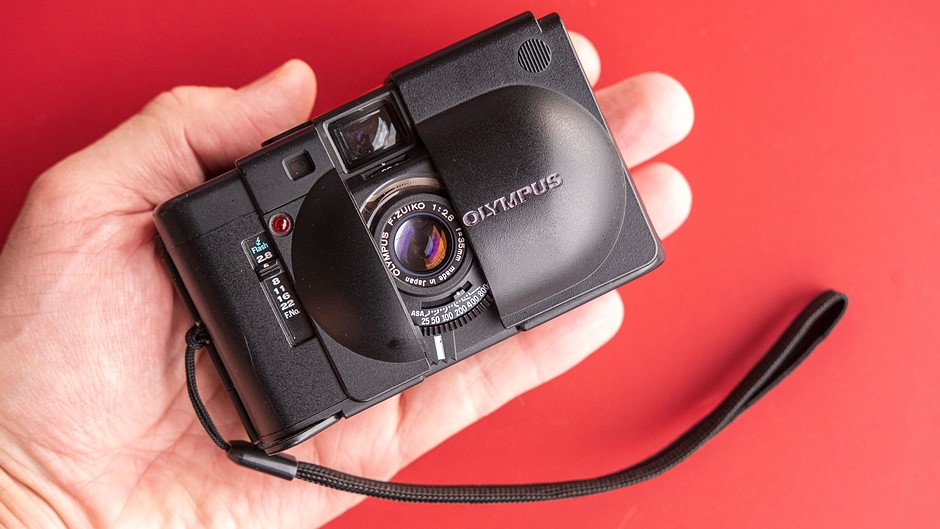
| The Olympus XA sports a sharp, fixed 35mm F/2.8 lens. Photo: Dan Bracaglia |
Olympus Cameras, now OM Digital Solutions, has been in the photography business long before most of us were born. From the original analog Pen F to the cult-status Stylus Epic (Mju II), there’s no shortage of legendary models to drool over. And I’m not just talking about film cameras – the modern digital Pen F is a sure-fire classic, too, as is the OG Pen E-PL1.
However, of all the brand’s releases – from 1936 to 2024 – my favorite is the charmingly petite Olympus XA rangefinder point-and-shoot from the late 1970s.
See used listings:
Olympus XA design and history
 |
| The XA is made for shooting from the hip. Photo: Dan Bracaglia |
Gone are the days when a simple sliding mechanical door doubled as a lens cover and an on/off switch. And that’s a shame. Sure, the aughts had their fair share of crappy, sliding-door, CC-sensor compacts. While some photographers certainly revel in that nostalgia, it’s still mostly a Gen Z thing.
Launched in May 1979, the Olympus XA goes back a little further. Built for maximum portability without the need for a case, it’s an aperture priority-only camera, and features a rather unique vertical lever for setting one’s F-stop, located to the left of the lens. Other controls include a small manual focus lever at the bottom, a large red square shutter release on top, and… that’s about it.
 |
| Olympus XA sample. Photo: Dan Bracaglia |
Given the lens’s teeny, tiny size, you might have some low expections of the optics. But peruse our samples below, and those on the greater internet, and you’ll come to one conclusion: it punches well above its weight. The optical formula is unsurprisingly simple: six elements in four groups – but sometimes, uncomplicated is better.
 |
| Olympus XA sample shot with the side-mounted Olympus A11 flash attached. Photo: Dan Bracaglia |
The XA has a four-bladed aperture but no onboard flash. Olympus sold several side-mounting accessory flash units alongside the XA. The Olympus A11 flash, in particular, produces some lovely, well-balanced results (see above). That said, the flash recycle time is comically long.
Olympus XA in use
 |
| A focus depth scale on top of the lens makes nailing sharp shots a breeze. Photo: Dan Bracaglia |
It’s cute, it’s capable, and it’s a bit of a pain in the ass to shoot with, mostly due to the small size of the focus tab and viewfinder. That said, once you conquer the Olympus XA learning curve, i.e., learn to shoot without relying too much on the undersized viewfinder, it’ll be smooth sailing.
Depending on the condition of your particular XA, the center focus patch in the viewfinder can be faint. This is not an issue I’ve encountered, but it is well-documented. Fortunately, an easy-to-read focus distance scale on the top of the lens serves as a reliable method for nailing sharp subjects.
Semi-auto or not, the XA doesn’t leave you in the dark about its exposure decisions. A match needle display on the left of the viewfinder indicates the camera’s current shutter speed of choice. Want to override that? You have one option: a lever on the bottom, when engaged, adds +1.5EV.
Olympus XA’s modern digital equivalents
 |
| The XA has no true digital equivalent, but the Ricoh GR IIIx comes close. Photo: Dan Bracaglia |
There are no tit-for-tat modern digital equivalents to the legendary film Olympus XA, but the Ricoh GR IIIx comes closest. Sporting a fixed 40mm equivalent F/2.8 lens and an APS-C sensor, it’s similarly built for shooting from the hip. Snap Focus mode allows users to set a default focus distance of choice, which is particularly handy for candids and street photography.
The next nearest digital equivalent is probably the Fujifilm X100 series. Though considerably larger than the XA and GR, these retro beauties boast a comparably faster 35mm equivalent f/2 lens paired with an APS-C sensor. They also sport a nifty hybrid optical/electronic viewfinder and plenty of old-school charm.
If you want to stick with the Olympus DNA, the rugged and compact OM System TG-7 is a great bet. Though it sports a smaller sensor than the cameras mentioned above (and can zoom), it’s highly pocketable, fairly simple to use and built to take a bruising.
Final thoughts and samples
 |
| Olympus XA sample. Photo: Dan Bracaglia |
The Olympus XA may be a relatively uncomplicated, semi-automatic relic of the analog photography era, but it’s still darn fun to shoot with and seriously capable, particularly given its diminutive size. A sharp lens in a tough-built, simple-to-use (once you get the hang of it) package — what’s not to love? And it’s full-frame!
These days, the cat’s out of the bag, and XA prices have gone through the roof. As little as seven years ago, tracking down a minty one for under $50 was a fairly simple feat. Now, you can expect to pay around $250.
 |
| Olympus XA sample. Photo: Dan Bracaglia |
However, don’t let the price deter you, especially if you’re curious about experiencing the joys of shooting with this charmingly little rangefinder. After all, you can always resell a working XA to another film fiend if the vibes aren’t meshing, without taking a financial shellacking. The fixed-lens 35mm compact camera market remains as hot as ever.
But I suspect that few who experience the XA will end up going that route. Moreover, if you’re lucky to come across a truly clean model with a bright focus patch, I have no doubt it’ll serve you well for years to come.
What’s your favorite fixed-lens 35mm camera? Let us know in the comments below.
See used listings:
Olympus XA sample photos
Sample images are owned by Dan Bracaglia and provided to DPReview. Please do not reproduce them without written permission from the photographer. All images are digital scans with light processing.




